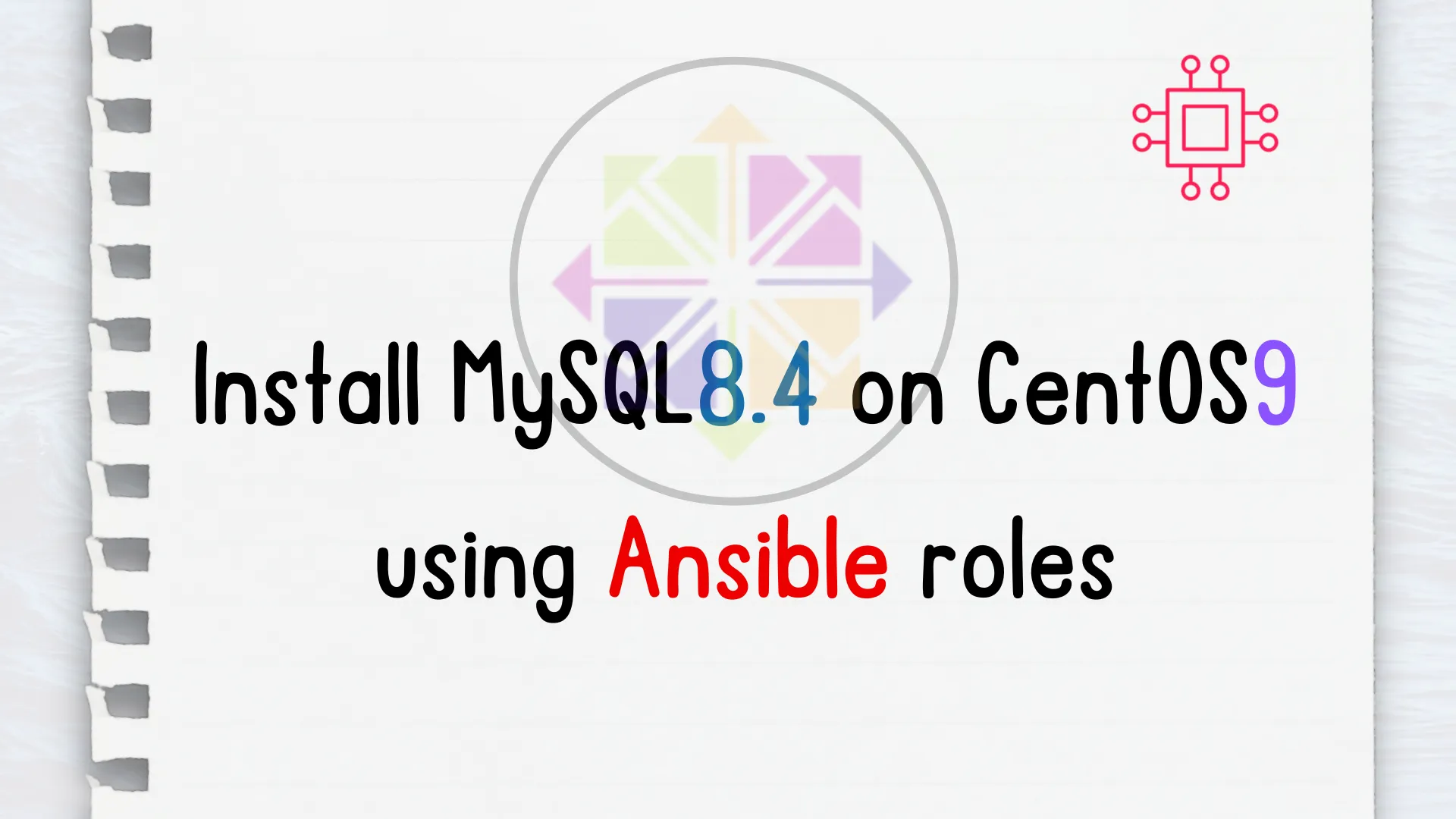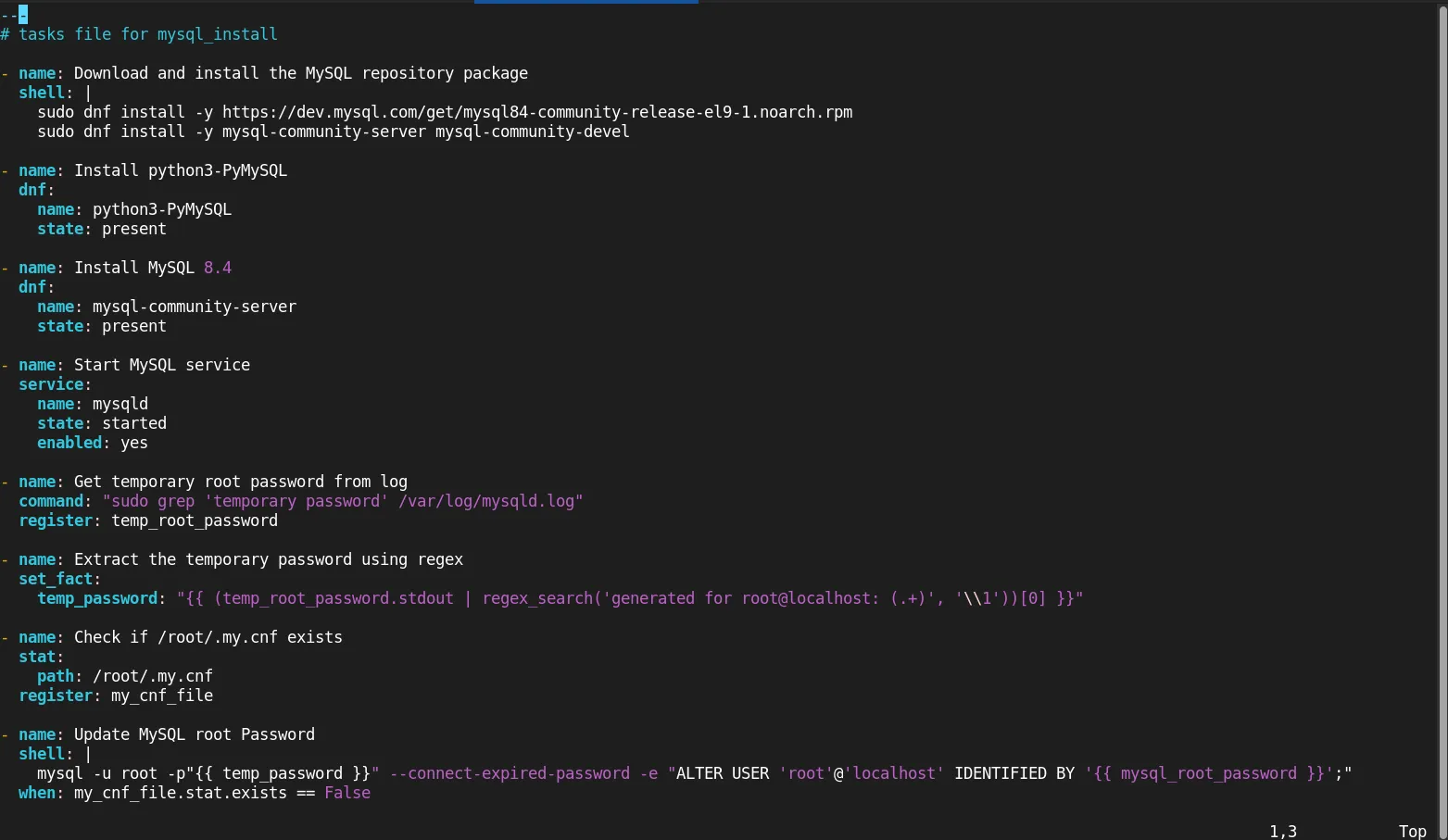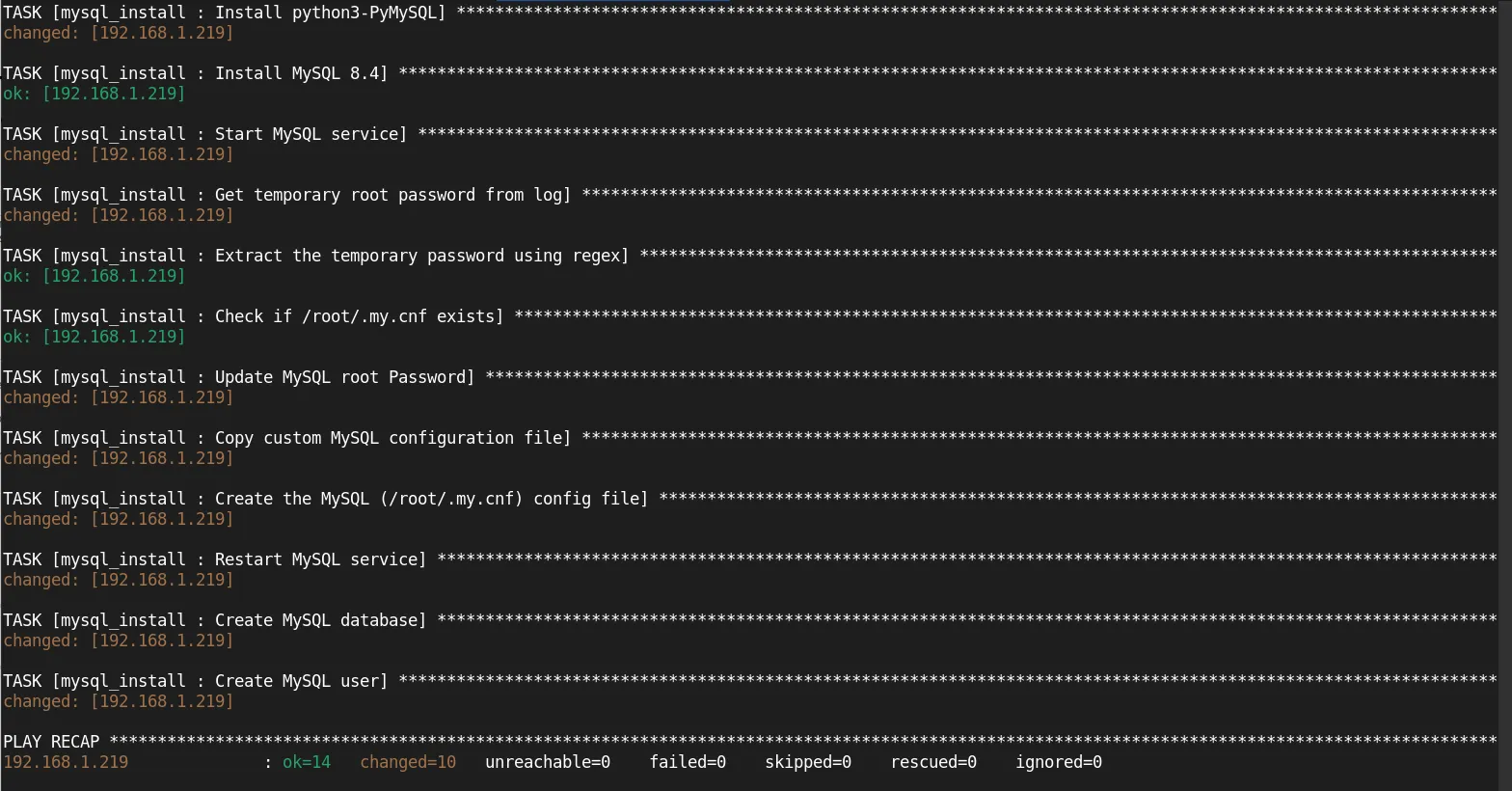
Learn how to install GitLab CE on RHEL 9 or CentOS 9 using Ansible roles. This comprehensive guide covers prerequisites, creating Ansible roles, executing playbooks, and

Learn how to install MySQL 8.4 on CentOS 9 using Ansible roles for automation, scalability, and repeatability. This step-by-step guide ensures a secure and efficient MySQL setup.
MySQL is an open-source relational database management system (RDBMS) widely used for web applications and services. When deploying MySQL across multiple servers or environments, automation becomes essential for consistency, repeatability, and scalability. This is where Ansible, an automation tool, comes in handy.
In this blog post, we will walk you through the process of installing MySQL 8.4 on a CentOS 9 server using Ansible roles. By using Ansible roles, you can organize your playbooks better, reuse code, and easily deploy MySQL on multiple servers. Whether you’re managing a single server or thousands, Ansible makes it easy to automate server configuration and application installation.
Let’s explore how you can use Ansible roles to automate the process of installing MySQL 8.4 on CentOS 9.
Why Use Ansible for Installing MySQL 8.4? |
Ansible is an open-source IT automation tool that simplifies tasks like software installation, system configuration, and application deployment. It enables you to:
| Benefit | Description |
|---|---|
| Automate repetitive tasks | Installing MySQL manually on multiple servers can be time-consuming and prone to errors. Ansible helps streamline this process. |
| Ensure consistency | Ansible playbooks ensure that the installation steps are identical across all servers, ensuring that MySQL is installed and configured consistently. |
| Manage large infrastructures | Whether you’re deploying on a few servers or hundreds, Ansible’s scalability helps manage large environments. |
| Reduce human errors | By automating the installation and configuration process, you reduce the likelihood of misconfiguration. |
Using Ansible roles allows for modularity and reusability. Roles help break down complex tasks into smaller, manageable components, making it easier to maintain and scale your playbooks.
For this demonstration, we’ve configured our CentOS 9 stream instance as follows:
| Hostname | RAM | Cores | OS |
| ansible.dev.naijalabs.net (management or control node) | 4 | 2 | Red Hat Enterprise Linux release 9.5 (Plow) |
| mysql-db.dev.naijalabs.net (target server or node) | IP: 192.168.1.219 | 4 | 2 | Red Hat Enterprise Linux release 9.5 (Plow) |
Before we start installing MySQL 8.4 using Ansible, ensure the following prerequisites are met:
CentOS 9 installed on the target servers.
Ansible installed on the local machine (or control node). If not installed, you can install Ansible using the following command:
sudo dnf install ansible -y
SSH access to the remote servers where you plan to install MySQL.
Sudo privileges on the target servers to install packages and configure MySQL.
Inventory file defining the list of target servers in Ansible.
To check the version running on your control node, run the following command:
ansible --version
ansible [core 2.14.18]
config file = /etc/ansible/ansible.cfg
configured module search path = ['/home/admin/.ansible/plugins/modules', '/usr/share/ansible/plugins/modules']
ansible python module location = /usr/lib/python3.9/site-packages/ansible
ansible collection location = /home/admin/.ansible/collections:/usr/share/ansible/collections
executable location = /usr/bin/ansible
python version = 3.9.21 (main, Dec 4 2024, 00:00:00) [GCC 11.5.0 20240719 (Red Hat 11.5.0-2)] (/usr/bin/python3)
jinja version = 3.1.2
libyaml = True
Ansible roles are a way to organize tasks, handlers, variables, templates, and files into reusable components. Roles allow you to encapsulate specific configurations, making it easier to apply consistent settings to multiple servers.
For installing MySQL 8.4 on CentOS 9, we’ll create a custom Ansible role that contains:
This structure helps ensure that your MySQL installation can be applied repeatedly and consistently.
Creating the MySQL Role |
To start, we need to create an Ansible role for installing MySQL 8.4. Ansible roles are created within the roles/ directory of your project. Run the following commands to create a mysql-84-install directory, navigate to it, and create a new role:
mkdir -p mysql-84-install && cd mysql-84-install && ansible-galaxy init mysql_install
- Role mysql_install was created successfully
This command generates the default structure for the MySQL installation role. The structure will look like this:
.
└── mysql_install
├── defaults
│ └── main.yml
├── files
├── handlers
│ └── main.yml
├── meta
│ └── main.yml
├── README.md
├── tasks
│ └── main.yml
├── templates
├── tests
│ ├── inventory
│ └── test.yml
└── vars
└── main.yml
9 directories, 8 files
Define your default variables |
The defaults/main.yml file in an Ansible role defines the default values for variables that can be overridden by the user, ensuring consistent configuration across tasks. Using your preferred text editor, open the mysql_install/defaults/main.yml file.
vim mysql_install/defaults/main.yml
Add the following content (then, save and quit the file):
---
# defaults file for mysql_install
# Define MySQL Database variables
mysql_hostname: "127.0.0.1"
mysql_port: "3306"
mysql_database: "my_database"
mysql_username: "my_user"
Securing your passwords |
Sensitive data, such as passwords, should be stored in an encrypted vault file (e.g., secrets.yml), not in plaintext within vars/main.yml or defaults/main.yml. Use vars_files in the playbook to reference the encrypted vault, and always protect the vault password, ensuring it’s not committed to version control.
Here’s how you do it. First, run the following command to create the secrets.yml file.
ansible-vault create mysql_install/vars/secrets.yml
New Vault password:
Confirm New Vault password:
When creating an encrypted vault file, you will be prompted to enter and confirm a password to secure access. Ensure that all sensitive variables, such as the MySQL user and root passwords, are included in the vault file to be referenced during playbook execution (replace with a strong, preferably 12-character+ password).
mysql_root_password: "j/ip{,uf7/oT"
mysql_user_password: "n#@xPHV4s@ve"
Save and quit the file. Now, store the password used to encrypt the secrets.yml (vault file) as plain text in a file we’re calling vaultpass.
vim .vaultpass
used-to-crack@mysql_#pass
Replace used-to-crack@mysql_#pass with your actual vault file password. Again, save and quit file.
Setting Up the MySQL Repository |
Next, we need to add the MySQL repository to CentOS 9. To do this, we will modify the tasks/main.yml file inside the mysql_install role.
Here’s how you would add the MySQL 8.4 repository:
vim mysql_install/tasks/main.yml
---
# tasks file for mysql_install
- name: Download and install the MySQL repository package
shell: |
sudo dnf install -y https://dev.mysql.com/get/mysql84-community-release-el9-1.noarch.rpm
sudo dnf install -y mysql-community-server mysql-community-devel
- name: Install python3-PyMySQL
dnf:
name: python3-PyMySQL
state: present
This snippet downloads and installs the MySQL 8.4 repository, enabling us to install MySQL 8.4 from the official MySQL repository.
Installing MySQL 8.4 |
Next, in the same tasks/main.yml file, you will define the task to install MySQL 8.4:
- name: Install MySQL 8.4
dnf:
name: mysql-community-server
state: present
Include the following tasks to extract the temporary password from the log file and update root password with the one you set in your vault file.
- name: Start MySQL service
service:
name: mysqld
state: started
enabled: yes
- name: Get temporary root password from log
command: "sudo grep 'temporary password' /var/log/mysqld.log"
register: temp_root_password
- name: Extract the temporary password using regex
set_fact:
temp_password: "{{ (temp_root_password.stdout | regex_search('generated for root@localhost: (.+)', '\\1'))[0] }}"
- name: Update MySQL root Password
shell: |
mysql -u root -p"{{ temp_password }}" --connect-expired-password -e "ALTER USER 'root'@'localhost' IDENTIFIED BY '{{ mysql_password }}';"
when: my_cnf_file.stat.exists == False
Important Note: Make sure to maintain the correct indentation when copying and pasting content. Incorrect indentation will lead to errors in execution!!
Your mysql_install/tasks/main.yml file should look like this (below) so far:

Photo by admingeek from Infotechys
After MySQL 8.4 is installed, you need to configure it. Here are the tasks for configuring MySQL in your role:
Creating Configuration Files for MySQL |
Create a configuration file (/etc/my.cnf) in the files/ directory of your role if you need to customize MySQL’s settings.
For example, here’s a basic my.cnf template:
vim mysql_install/files/my.cnf
[mysqld]
bind-address = 0.0.0.0
sql_mode=STRICT_TRANS_TABLES,NO_ENGINE_SUBSTITUTION
# Enable mysql_native_password plugin
mysql_native_password=ON
This configuration ensures MySQL listens on all interfaces, enforces strict SQL standards, and enables compatibility for older authentication methods.
| Configuration | Description |
|---|---|
bind-address = 0.0.0.0 | Makes MySQL listen for connections on all available network interfaces, allowing remote access from any IP address. This could pose a security risk if not properly secured. |
sql_mode = STRICT_TRANS_TABLES,NO_ENGINE_SUBSTITUTION | Sets SQL modes for MySQL: <ul><li>STRICT_TRANS_TABLES: Enforces strict validation for transactional tables, causing errors on invalid or missing values.</li><li>NO_ENGINE_SUBSTITUTION: Prevents MySQL from using an alternative engine if the requested engine is unavailable.</li></ul> |
mysql_native_password = ON | Enables the mysql_native_password authentication plugin, which is commonly used for compatibility and is necessary for certain MySQL clients or older versions to authenticate. |
Let’s reference this file in your role’s tasks/main.yml to copy the configuration to the target server:
vim mysql_install/tasks/main.yml
- name: Copy custom MySQL configuration file
copy:
src: my.cnf
dest: /etc/my.cnf
owner: root
group: root
mode: '0644'
Additionally, include an entry to create a /root/.my.cnf file that stores the MySQL root password.
- name: Create the MySQL (/root/.my.cnf) config file
copy:
dest: /root/.my.cnf
content: |
[client]
user=root
password={{ mysql_root_password }}
Restart the database to allow changes to take effect.
- name: Restart MySQL service
service:
name: mysqld
state: restarted
enabled: yes
Setting Up MySQL Users and Databases |
In the tasks/main.yml, you can also include tasks to create users and databases:
- name: Create MySQL database
community.mysql.mysql_db:
name: "{{ mysql_database }}"
state: present
login_user: root
login_password: "{{ mysql_root_password }}"
- name: Create MySQL user
community.mysql.mysql_user:
name: "{{ mysql_username }}"
password: "{{ mysql_user_password }}"
priv: "{{ mysql_database }}.*:ALL"
state: present
login_user: root
login_password: "{{ mysql_root_password }}"
Once MySQL is installed and configured, ensure that the service is started and enabled to start on boot. In the handlers/main.yml file, create a handler to restart MySQL if any changes occur.
vim mysql_install/handlers/main.yml
---
# handlers file for mysql_install
- name: Start MySQL service
service:
name: mysqld
state: started
enabled: yes
This task ensures that MySQL starts and is enabled to start on reboot.
Before running the playbook, let’s define the host or hosts for the test run. In the tests/inventory file, specify the target host(s). In this example, we’ve included the IP address of our CentOS 9 server (mysql-db.dev.naijalabs.net).
vim mysql_install/tests/inventory
[mysql_database_server]
192.168.1.219 ansible_ssh_user=admin
Finally, we can create a mysql_db_install.yml file in the role’s root directory. Your directory structure should now include the following:
.
├── mysql_db_install.yml
├── mysql_install
│ ├── defaults
│ │ └── main.yml
│ ├── files
│ │ └── my.cnf
│ ├── handlers
│ │ └── main.yml
│ ├── meta
│ │ └── main.yml
│ ├── README.md
│ ├── tasks
│ │ └── main.yml
│ ├── templates
│ ├── tests
│ │ ├── inventory
│ │ └── test.yml
│ └── vars
│ ├── main.yml
│ └── secrets.yml
└── vaultpass
9 directories, 12 files
Open the mysql_db_install.yml file and add the following content:
vim mysql_db_install.yml
---
- name: Install MySQL 8.4 Database on CentOS 9
hosts: mysql_database_server
vars_files:
- mysql_install/vars/secrets.yml
become: true
roles:
- mysql_install
Run the following command to execute the playbook:
ansible-playbook -i mysql_install/tests/inventory mysql_db_install.yml -K --vault-password-file .vaultpass
When the playbook is finished running, you should have an operational MySQL Database!

Photo by admingeek from Infotechys
After running the Ansible role to install and configure MySQL, it’s important to test the installation to ensure everything is working correctly. Use the following command to check MySQL’s status:
systemctl status mysqld
● mysqld.service - MySQL Server
Loaded: loaded (/usr/lib/systemd/system/mysqld.service; enabled; preset: disabled)
Active: active (running) since Tue 2025-02-04 03:26:28 EST; 49s ago
Docs: man:mysqld(8)
http://dev.mysql.com/doc/refman/en/using-systemd.html
Process: 10088 ExecStartPre=/usr/bin/mysqld_pre_systemd (code=exited, status=0/SUCCESS)
Main PID: 10115 (mysqld)
Status: "Server is operational"
Tasks: 36 (limit: 23127)
Memory: 433.8M
CPU: 37.367s
CGroup: /system.slice/mysqld.service
└─10115 /usr/sbin/mysqld
You can also test logging into MySQL:
sudo mysql -u root -p
Enter password:
Welcome to the MySQL monitor. Commands end with ; or \g.
Your MySQL connection id is 10
Server version: 8.4.4 MySQL Community Server - GPL
Copyright (c) 2000, 2025, Oracle and/or its affiliates.
Oracle is a registered trademark of Oracle Corporation and/or its
affiliates. Other names may be trademarks of their respective
owners.
Type 'help;' or '\h' for help. Type '\c' to clear the current input statement.
mysql>
Run the following command to show the default databases and confirm your database was created:
SHOW DATABASES;
+--------------------+
| Database |
+--------------------+
| information_schema |
| my_database |
| mysql |
| performance_schema |
| sys |
+--------------------+
5 rows in set (0.00 sec)
To ensure a clean and efficient deployment of MySQL, here are a few best practices:
| Best Practice | Explanation |
|---|---|
| Use Configuration Management | Always store configuration files (e.g., my.cnf) in version-controlled systems. |
| Ensure Idempotency | Make sure your playbooks and roles are idempotent, i.e., they should work even if run multiple times. |
| Use Variables for Passwords | Avoid hardcoding sensitive information like passwords. Use Ansible vault to store secrets securely. |
| Regularly Update MySQL | Keep MySQL up to date to ensure security patches and new features are installed. |
Here are some common issues you might encounter:
/var/log/mysqld.log for more information.By following this guide, you can automate the process of installing MySQL 8.4 on CentOS 9 using Ansible roles. Automating MySQL installation and configuration with Ansible not only saves time but also ensures consistency and scalability, especially when managing large infrastructures.
Ansible roles allow you to modularize your playbooks and reuse them across different environments. With the power of Ansible, you can efficiently manage MySQL installations and configurations, reducing manual errors and improving overall productivity.
Did you find this article useful? Your feedback is invaluable to us! Please feel free to share this post!

Learn how to install GitLab CE on RHEL 9 or CentOS 9 using Ansible roles. This comprehensive guide covers prerequisites, creating Ansible roles, executing playbooks, and

Learn how to effortlessly deploy and manage a LAMP stack on RHEL9 using Ansible. Streamline your server setup with automation! Table of Contents Introduction Hey
